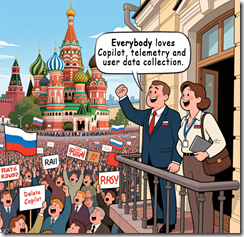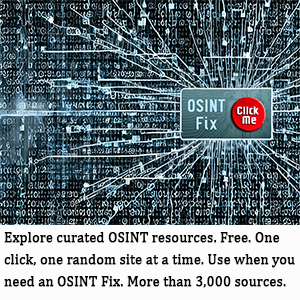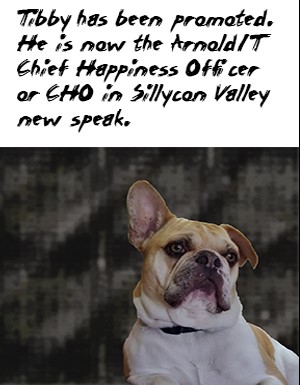How Do You Get Numbers for Copilot? Microsoft Has a Good Idea
December 22, 2025
 Another dinobaby post. No AI unless it is an image. This dinobaby is not Grandma Moses, just Grandpa Arnold.
Another dinobaby post. No AI unless it is an image. This dinobaby is not Grandma Moses, just Grandpa Arnold.
In past couple of days, I tested some of the latest and greatest from the big tech outfits destined to control information flow. I uploaded text to Gemini, asked it a question answered in the test, and it spit out the incorrect answer. Score one for the Googlers. Then I selected an output from ChatGPT and asked it to determine who was really innovating in a very, very narrow online market space. ChatGPT did not disappoint. It just made up a non-existent person. Okay Sam AI-Man, I think you and Microsoft need to do some engineering.

Could a TV maker charge users to uninstall a high value service like Copilot? Could Microsoft make the uninstall app available for a fee via its online software store? Could both the TV maker and Microsoft just ignore the howls of the demented few who don’t love Copilot? Yeah, I go with ignore. Thanks, Venice.ai. Good enough.
And what did Microsoft do with its Copilot online service? According to Engadget, “LG quietly added an unremovable Microsoft Copilot app to TVs.” The write up reports:
Several LG smart TV owners have taken to Reddit over the past few days to complain that they suddenly have a Copilot app on the device
But Microsoft has a seductive way about its dealings. Engadget points out:
[LG TV owners] cannot uninstall it.
Let’s think about this. Most smart TVs come with highly valuable to the TV maker baloney applications. These can be uninstalled if one takes the time. I don’t watch TV very much, so I just leave the set the way it was. I routinely ignore pleas to update the software. I listen, so I don’t care if weird reminders obscure the visuals.
The Engadget article states:
LG said during the 2025 CES season that it would have a Copilot-powered AI Search in its next wave of TV models, but putting in a permanent AI fixture is sure to leave a bad taste in many customers’ mouths, particularly since Copilot hasn’t been particularly popular among people using AI assistants.
Okay, Microsoft has a vision for itself. It wants to be the AI operating system just as Google and other companies desire. Microsoft has been a bit pushy. I suppose I would come up with ideas that build “numbers” and provide fodder for the Microsoft publicity machine. If I hypothesize myself in a meeting at Microsoft (where I have been but that was years ago), I would reason this way:
- We need numbers.
- Why not pay a TV outfit to install Copilot.
- Then either pay more or provide some inducements to our TV partner to make Copilot permanent; that is, the TV owner has no choice.
The pushback for this hypothetical suggestion would be:
- How much?
- How many for sure?
- How much consumer backlash?
I further hypothesize that I would say:
- We float some trial balloon numbers and go from there.
- We focus on high end models because those people are more likely to be willing to pay for additional Microsoft services
- Who cares about consumer backlash? These are TVs and we are cloud and AI people.
Obviously my hypothetical suggestion or something similar to it took place at Microsoft. Then LG saw the light or more likely the check with some big numbers imprinted on it, and the deal was done.
The painful reality of consumer-facing services is that something like 95 percent of the consumers do not change the defaults. By making something uninstallable will not even register as a problem for most consumers.
Therefore, the logic of the LG play is rock solid. Microsoft can add the LG TVs with Copilot to its confirmed Copilot user numbers. Win.
Microsoft is not in the TV business so this is just advertising. Win
Microsoft is not a consumer product company like a TV set company. Win.
As a result, the lack of an uninstall option makes sense. If a lawyer or some other important entity complains, making Copilot something a user can remove eliminates the problem.
Love those LGs. Next up microwaves, freezers, smart lights, and possibly electric blankets. Numbers are important. Users demonstrate proof that Microsoft is on the right path.
But what about revenue from Copilot. No problem. Raise the cost of other services. Charging Outlook users per message seems like an idea worth pursuing? My hypothetical self would argue with type of toll or taxi meter approach. A per pixel charge in Paint seems plausible as well.
The reality is that I believe LG will backtrack. Does it need the grief?
Stephen E Arnold, December 22, 2025
Windows Strafed by Windows Fanboys: Incredible Flip
December 19, 2025
 Another dinobaby post. No AI unless it is an image. This dinobaby is not Grandma Moses, just Grandpa Arnold.
Another dinobaby post. No AI unless it is an image. This dinobaby is not Grandma Moses, just Grandpa Arnold.
When the Windows folding phone came out, I remember hunting around for blog posts, podcasts, and videos about this interesting device. Following links I bumbled onto the Windows Central Web site. The two fellows who seemed to be front and center had a podcast (a quite irregularly published podcast I might add). I was amazed at the pro-folding gizmo. One of the write ups was panting with excitement. I thought then and think now that figuring out how to fold a screen is a laboratory exercise, not something destined to be part of my mobile phone experience.
I forgot about Windows Central and the unflagging ability to find something wonderfully bigly about the Softies. Then I followed a link to this story: “Microsoft Has a Problem: Nobody Wants to Buy or Use Its Shoddy AI Products — As Google’s AI Growth Begins to Outpace Copilot Products.”

An athlete failed at his Dos Santos II exercise. The coach, a tough love type, offers the injured gymnast a path forward with Mistral AI. Thanks, Qwen, do you phone home?
The cited write up struck me as a technology aficionado pulling off what is called a Dos Santos II. (If you are not into gymnastics, this exercise “trick” involves starting backward with a half twist into a double front in the layout position. Boom. Perfect 10. From folding phone to “shoddy AI products.”
If I were curious, I would dig into the reasons for this change in tune, instruments, and concert hall. My hunch is that a new manager replaced a person who was talking (informally, of course) to individuals who provided the information without identifying the source. Reuters, the trust outfit, does this on occasion as do other “real” journalists. I prefer to say, here are my observations or my hypotheses about Topic X. Others just do the “anonymous” and move forward in life.
Here are a couple of snips from the write up that I find notable. These are not quite at the “shoddy AI products” level, but I find them interesting.
Snippet 1:
If there’s one thing that typifies Microsoft under CEO Satya Nadella‘s tenure: it’s a general inability to connect with customers. Microsoft shut down its retail arm quietly over the past few years, closed up shop on mountains of consumer products, while drifting haphazardly from tech fad to tech fad.
I like the idea that Microsoft is not sure what it is doing. Furthermore, I don’t think Microsoft every connected with its customers. Connections come from the Certified Partners, the media lap dogs fawning at Microsoft CEO antics, and brilliant statements about how many Russian programmers it takes to hack into a Windows product. (Hint: The answer is a couple if the Telegram posts I have read are semi accurate.)
Snippet 2:
With OpenAI’s business model under constant scrutiny and racking up genuinely dangerous levels of debt, it’s become a cascading problem for Microsoft to have tied up layer upon layer of its business in what might end up being something of a lame duck.
My interpretation of this comment is that Microsoft hitched its wagon to one of AI’s Cybertrucks, and the buggy isn’t able to pull the Softie’s one-horse shay. The notion of a “lame duck” is that Microsoft cannot easily extricate itself from the money, the effort, the staff, and the weird “swallow your AI medicine, you fool” approach the estimable company has adopted for Copilot.
Snippet 3:
Microsoft’s “ship it now fix it later” attitude risks giving its AI products an Internet Explorer-like reputation for poor quality, sacrificing the future to more patient, thoughtful companies who spend a little more time polishing first. Microsoft’s strategy for AI seems to revolve around offering cheaper, lower quality products at lower costs (Microsoft Teams, hi), over more expensive higher-quality options its competitors are offering. Whether or not that strategy will work for artificial intelligence, which is exorbitantly expensive to run, remains to be seen.
A less civilized editor would have dropped in the industry buzzword “crapware.” But we are stuck with “ship it now fix it later” or maybe just never. So far we have customer issues, the OpenAI technology as a lame duck, and now the lousy software criticism.
Okay, that’s enough.
The question is, “Why the Dos Santos II” at this time? I think citing the third party “Information” is a convenient technique in blog posts. Heck, Beyond Search uses this method almost exclusively except I position what I do as an abstract with critical commentary.
Let my hypothesize (no anonymous “source” is helping me out):
- Whoever at Windows Central annoyed a Softie with power created is responding to this perceived injustice
- The people at Windows Central woke up one day and heard a little voice say, “Your cheerleading is out of step with how others view Microsoft.” The folks at Windows Central listened and, thus, the Dos Santos II.
- Windows Central did what the auth9or of the article states in the article; that is, using multiple AI services each day. The Windows Central professional realized that Copilot was not as helpful writing “real” news as some of the other services.
Which of these is closer to the pin? I have no idea. Today (December 12, 2025) I used Qwen, Anthropic, ChatGPT, and Gemini. I want to tell you that these four services did not provide accurate output.
Windows Central gets a 9.0 for its flooring Microsoft exercise.
Stephen E Arnold, December 19, 2025
Microsoft Demonstrates Its Commitment to Security. Right, Copilot
December 4, 2025
 Another dinobaby post. No AI unless it is an image. This dinobaby is not Grandma Moses, just Grandpa Arnold.
Another dinobaby post. No AI unless it is an image. This dinobaby is not Grandma Moses, just Grandpa Arnold.
I read on November 20, 2025, an article titled “Critics Scoff after Microsoft Warns AI Feature Can Infect Machines and Pilfer Data.” My immediate reaction was, “So what’s new?” I put the write up aside. I had to run an errand, so I grabbed the print out of this Ars Technica story in case I had to wait for the shop to hunt down my dead lawn mower.

A hacking club in Moscow celebrates Microsoft’s decision to enable agents in Windows. The group seems quite happy despite sanctions, food shortages, and the special operation. Thanks, MidJourney. Good enough.
I worked through the short write up and spotted a couple of useful (if true) factoids. It may turn out that the information in this Ars Technica write up provide insight about Microsoft’s approach to security. If I am correct, threat actors, assorted money laundering outfits, and run-of-the-mill state actors will be celebrating. If I am wrong, rest easy. Cyber security firms will have no problem blocking threats — for a small fee of course.
The write up points to what the article calls a “warning” from Microsoft on November 18, 2025. The report says:
an experimental AI agent integrated into Windows can infect devices and pilfer sensitive user data
Yep, Ars Technica then puts a cherry on top with this passage:
Microsoft introduced Copilot Actions, a new set of “experimental agentic features” that, when enabled, perform “everyday tasks like organizing files, scheduling meetings, or sending emails,” and provide “an active digital collaborator that can carry out complex tasks for you to enhance efficiency and productivity.”
But don’t worry. Users can use these Copilot actions:
if you understand the security implications.
Wow, that’s great. We know from the psycho-pop best seller Thinking Fast and Slow that more than 80 percent of people cannot figure out how much a ball costs if the total is $1.10 and the ball costs one dollar more. Also, Microsoft knows that most Windows users do not disable defaults. I think that even Microsoft knows that turning on agentic magic by default is not a great idea.
Nevertheless, this means that agents combined with large language models are sparking celebrations among the less trustworthy sectors of those who ignore laws and social behavior conventions. Agentic Windows is the new theme part for online crime.
Should you worry? I will let you decipher this statement allegedly from Microsoft. Make up your own mind, please:
“As these capabilities are introduced, AI models still face functional limitations in terms of how they behave and occasionally may hallucinate and produce unexpected outputs,” Microsoft said. “Additionally, agentic AI applications introduce novel security risks, such as cross-prompt injection (XPIA), where malicious content embedded in UI elements or documents can override agent instructions, leading to unintended actions like data exfiltration or malware installation.”
I thought this sub head in the article exuded poetic craft:
Like macros on Marvel superhero crack
The article reports:
Microsoft’s warning, one critic said, amounts to little more than a CYA (short for cover your ass), a legal maneuver that attempts to shield a party from liability. “Microsoft (like the rest of the industry) has no idea how to stop prompt injection or hallucinations, which makes it fundamentally unfit for almost anything serious,” critic Reed Mideke said. “The solution? Shift liability to the user. Just like every LLM chatbot has a ‘oh by the way, if you use this for anything important be sure to verify the answers” disclaimer, never mind that you wouldn’t need the chatbot in the first place if you knew the answer.”
Several observations are warranted:
- How about that commitment to security after SolarWinds? Yeah, I bet Microsoft forgot that.
- Microsoft is doing what is necessary to avoid the issues that arise when the Board of Directors has a macho moment and asks whoever is the Top Dog at the time, “What about the money spent on data centers and AI technology? You know, How are you going to recoup those losses?
- Microsoft is not asking its users about agentic AI. Microsoft has decided that the future of Microsoft is to make AI the next big thing. Why? Microsoft is an alpha in a world filled with lesser creatures. The answer? Google.
Net net: This Ars Technica article makes crystal clear that security is not top of mind among Softies. Hey, when’s the next party?
Stephen E Arnold, December 4, 2025
Microsoft: Desperate to Be a Leader in the Agentic OS Push Decides to Shove, Not Lure Supporters
November 26, 2025
 Another short essay from a real and still-alive dinobaby. If you see an image, we used AI. The dinobaby is not an artist like Grandma Moses.
Another short essay from a real and still-alive dinobaby. If you see an image, we used AI. The dinobaby is not an artist like Grandma Moses.
I had a friend in high school who like a girl Mary B. He smiled at her. He complimented her plaid skirt. He gave her a birthday gift during lunch in the school cafeteria. My reaction to this display was, “Yo, Tommy, you are trying too hard.” I said nothing, I watched as Mary B. focused her attention on a football player with a C average but comic book Superman looks. Tommy became known as a person who tried too hard to reach a goal without realizing no girl wanted to be the focal point of a birthday gift in the school cafeteria with hundreds of students watching. Fail, Tommy.

Thanks, Venice.ai. Good enough, the gold standard today I believe.
I thought about this try-too-hard approach when I read “Windows President Addresses Current State of Windows 11 after AI Backlash.” The source is the on-again, off-again podcasting outfit called Windows Central. Here’s a snippet from the write up which recycles content from X.com. The source of the statement is a person named Pavan Davuluri, who is the Microsoft Windows lead:
The team (and I) take in a ton of feedback. We balance what we see in our product feedback systems with what we hear directly. They don’t always match, but both are important. I’ve read through the comments and see focus on things like reliability, performance, ease of use and more… we care deeply about developers. We know we have work to do on the experience, both on the everyday usability, from inconsistent dialogs to power user experiences. When we meet as a team, we discuss these pain points and others in detail, because we want developers to choose Windows.
Windows Central pointed out that Lead Davuluri demonstrated “leadership” with a bold move. He disabled comments to his X.com post about caring deeply about its customers. I like it when Lead Davuluri takes decisive leadership actions that prevent people from providing inputs. Is that why Microsoft ignored focus groups responding to Wi-Fi hardware that did not work and “ribbon” icons instead of words in Office application interfaces? I think I have possibly identified a trend at Microsoft: The aircraft carrier is steaming forward, and it is too bad about the dolphins, fishing boats, and scuba divers. I mean who cares about these unseen flotsam and jetsam.
Remarkably Windows Central’s write up includes another hint of negativism about Microsoft Windows:
What hasn’t helped in recent years is “Continuous Innovation,” Microsoft’s update delivery strategy that’s designed to keep the OS fresh with new features and changes on a consistent, monthly basis. On paper, it sounds like a good idea, but in practice, updating Windows monthly with new features often causes more headaches than joy for a lot of people. I think most users would prefer one big update at a predictable, certain time of the year, just like how Apple and Google do it.
Several observations if I may offer them as an aged dinobaby:
- Google has said it wants to become the agentic operating system. That means Google wants to kill off Microsoft, its applications, and its dreams.
- Microsoft knows that it faces competition from a person whom Satya Nadella knows, understands, absolutely must defeat because his family would make fun of him if he failed. Yep, a man-to-man dust up with annoying users trying to stop the march of technological innovation and revenue. Lead Davuluri has his marching orders; hence, the pablum tinged non-speak cited in the Windows Central write up.
- User needs and government regulation have zero — that’s right, none, nil, zip — chance of altering what these BAIT (big AI tech) outfits will do to win. Buckle up, Tommy. You are going to be rejected again.
Net net: That phrase agentic OS has a ring to it, doesn’t it?
Stephen E Arnold, November 26, 2025
Microsoft Factoid: 30 Percent of Our Code Is Vibey
November 24, 2025
 Another short essay from a real and still-alive dinobaby. If you see an image, we used AI. The dinobaby is not an artist like Grandma Moses.
Another short essay from a real and still-alive dinobaby. If you see an image, we used AI. The dinobaby is not an artist like Grandma Moses.
Is Microsoft cranking out one fifth to one third of its code using vibey methods? A write up from Ibrahim Diallo seeks to answer this question in his essay “Is 30% of Microsoft’s Code Really AI-Generated?” My instinctive response was, “Nope. Marketing.” Microsoft feels the heat. The Google is pushing the message that it will deliver the Agentic Operating System for the emergence of a new computing epoch. In response, Microsoft has been pumping juice into its market collateral. For example, Microsoft is building data center systems that span nations. Copilot will make your Notepad “experience” more memorable. Visio, a step child application, is really cheap. Add these steps together, and you get a profile of a very large company under pressure and showing signs of cracking. Why? Google is turning up the heat and Microsoft feels it.
Mr. Diallo writes:
A few months back, news outlets were buzzing with reports that Satya Nadella claimed 30% of the code in Microsoft’s repositories was AI-generated. This fueled the hype around tools like Copilot and Cursor. The implication seemed clear: if Microsoft’s developers were now “vibe coding,” everyone should embrace the method.
Then he makes a pragmatic observation:
The line between “AI-generated” and “human-written” code has become blurrier than the headlines suggest. And maybe that’s the point. When AI becomes just another tool in the development workflow, like syntax highlighting or auto-complete, measuring its contribution as a simple percentage might not be meaningful at all.
Several observations:
- Microsoft’s leadership is outputting difficult to believe statements
- Microsoft apparently has been recycling code because those contributions from Stack Overflow are not tabulated
- Marketing is now the engine making AI the future of Microsoft unfold.
I would assert that the answer to the Mr. Diallo’s question is, “Whatever unfounded assertion Microsoft offers is actual factual.” That’s okay with me, but some people may be hooked by Google’s Agentic Operating System pitch.
Stephen E Arnold, November 24, 2025
Microsoft Knows How to Avoid an AI Bubble: Listen Up, Grunts, Discipline Now!
November 18, 2025
 Another short essay from a real and still-alive dinobaby. If you see an image, we used AI. The dinobaby is not an artist like Grandma Moses.
Another short essay from a real and still-alive dinobaby. If you see an image, we used AI. The dinobaby is not an artist like Grandma Moses.
I relish statements from the leadership of BAIT (big AI tech) outfits. A case in point is Microsoft. The Fortune story “AI Won’t Become a Bubble As Long As Everyone Stays thoughtful and Disciplined, Microsoft’s Brad Smith Says.” First, let’s consider the meaning of the word “everyone.” I navigated to Yandex.com and used its Alice smart software to get the definition of “everyone”:
The word “everyone” is often used in social and organizational contexts, and to denote universal truths or principles.
That’s a useful definition. Universal truths and principles. If anyone should know, it is Yandex.

Thanks, Venice.ai. Good enough, but the Russian flag is white, blue, and red. Your inclusion of Ukraine yellow was one reason why AI is good enough, not a slam dunk.
But isn’t there a logical issue with the subjective flag “if” and then a universal assertion about everyone? I find the statement illogical. It mostly sounds like English, but it presents a wild and crazy idea at a time when agreement about anything is quite difficult to achieve. Since I am a dinobaby, my reaction to the Fortune headline is obviously out of touch with the “real” world as it exists are Fortune and possibly Microsoft.
Let’s labor forward with the write up, shall we?
I noted this statement in the cited article attributed to Microsoft’s president Brad Smith:
“I obviously can’t speak about every other agreement in the AI sector. We’re focused on being disciplined but being ambitious. And I think it’s the right combination,” he said. “Everybody’s going to have to be thoughtful and disciplined. Everybody’s going to have to be ambitious but grounded. I think that a lot of these companies are [doing that].”
It was not Fortune’s wonderful headline writers who stumbled into a logical swamp. The culprit or crafter of the statement was “1000 Russian programmers did it” Smith. It is never Microsoft’s fault in my view.
But isn’t this the AI go really fast, don’t worry about the future, and break things?
Mr. Smith, according the article said,
“We see ongoing growth in demand. That’s what we’ve seen over the past year. That’s what we expect today, and frankly our biggest challenge right now is to continue to add capacity to keep pace with it.”
I wonder if Microsoft’s hiring social media influencers is related to generating demand and awareness, not getting people to embrace Copilot. Despite its jumping off the starting line first, Microsoft is now lagging behind its “partner” OpenAI and a two or three other BAIT entities.
The Fortune story includes supporting information from a person who seems totally, 100 percent objective. Here’s the quote:
At Web Summit, he met Anton Osika, the CEO of Lovable, a vibe-coding startup that lets anyone create apps and software simply by talking to an AI model. “What they’re doing to change the prototyping of software is breathtaking. As much as anything, what these kinds of AI initiatives are doing is opening up technology opportunities for many more people to do more things than they can do before…. This will be one of the defining factors of the quarter century ahead…”
I like the idea of Microsoft becoming a “defining factor” for the next 25 years. I would raise the question, “What about the Google? Is it chopped liver?
Several observations:
- Mr. Smith’s informed view does not line up with hiring social media influencers to handle the “growth and demand.” My hunch is that Microsoft fears that it is losing the consumer perception of Microsoft as the really Big Dog. Right now, that seems to be Super sized OpenAI and the mastiff-like Gemini.
- The craziness of “everybody” illustrates a somewhat peculiar view of consensus today. Does everybody include those fun-loving folks fighting in the Russian special operation or the dust ups in Sudan to name two places where “everybody” could be labeled just plain crazy?
- Mr. Smith appears to conflate putting Copilot in Notepad and rolling out Clippy in Yeezies with substantive applications not prone to hallucinations, mistakes, and outputs that could get some users of Excel into some quite interesting meetings with investors and clients.
Net net: Yep, everybody. Not going to happen. But the idea is a-thoughtful, which is interesting to me.
Stephen E Arnold, November 18, 2025
Microsoft Could Be a Microsnitch
November 14, 2025
Remember when you were younger and the single threat of, “I’m going to tell!” was enough to send chills through your body? Now Microsoft plans to do the same thing except on an adult level. Life Hacker shares that, “Microsoft Teams Will Soon Tell Your Boss When You’re Not In The Office.” The article makes an accurate observation that since the pandemic most jobs can be done from anywhere with an Internet connection.
Since the end of quarantine, offices are fighting to get their workers back into physical workspaces. Some of them have implemented hybrid working, while others have become more extreme by counting clock-ins and badge swipes. Microsoft is adding its own technology to the fight by making it possible to track remote workers.
“As spotted by Tom’s Guide, Microsoft Teams will roll out an update in December that will have the option to report whether or not you’re working from your company’s office. The update notes are sparse on details, but include the following: ‘When users connect to their organization’s [wifi], Teams will soon be able to automatically update their work location to reflect the building they’re working from. This feature will be off by default. Tenant admins will decide whether to enable it and require end-users to opt-in.’”
Microsoft whitewashed the new feature by suggesting employees use it to find their teammates. The article’s author says it all:
“But let’s be real. This feature is also going to be used by companies to track their employees, and ensure that they’re working from where they’re supposed to be working from. Your boss can take a look at your Teams status at any time, and if it doesn’t report you’re working from one of the company’s buildings, they’ll know you’re not in the office. No, the feature won’t be on by default, but if your company wants to, your IT can switch it on, and require that you enable it on your end as well.”
It is ridiculous to demand that employees return to offices, but at the same time many workers aren’t actually doing their job. The professionals are quiet quitting, pretending to do the work, and ignoring routine tasks. Surveillance seems to be a solution of interest.
It would be easier if humans were just machines. You know, meat AI systems. Bummer, we’re human. If we can get away with something, many will. But is Microsoft is going too far here to make sales to ineffective “leadership”? Worker’s aren’t children, and the big tech company is definitely taking the phrase, “I’m going to tell!” to heart.
Whitney Grace, November 14, 2025
Sweet Dreams of Data Centers for Clippy Version 2: The Agentic Operation System
November 13, 2025
 Another short essay from a real and still-alive dinobaby. If you see an image, we used AI. The dinobaby is not an artist like Grandma Moses.
Another short essay from a real and still-alive dinobaby. If you see an image, we used AI. The dinobaby is not an artist like Grandma Moses.
If you have good musical recall, I want you to call up the tune for “Sweet Dreams (Are Made of This) by the Eurythmics. Okay, with that sound track buzzing through your musical memory, put it on loop. I want to point you to two write ups about Microsoft’s plans for a global agentic operating system and its infrastructure. From hiring social media influencers to hitting the podcast circuit, Microsoft is singing its own songs to its often reluctant faithful. Let’s turn down “Sweet Dream” and crank up the MSFT chart climbers.

Trans-continental AI infrastructure. Will these be silent, reduce pollution, and improve the life of kids who live near the facilities? Of course, because some mommies will say, “Just concentrate and put in your ear plugs. I am not telling you again.” Thanks, Venice. Good enough after four tries. Par for the AI course.
The first write up is by the tantalizingly named consulting firm doing business as SemiAnalysis. I smile everything I think about how some of my British friends laugh when they see a reference to a semi-truck. One quipped, “What you don’t have complete trucks in the US?” That same individual would probably say in response to the company name SemiAnalysis, “What you don’t have a complete analysis in the US?” I have no answer to either question, but “SemiAnalysis” does strike me as more amusing a moniker than Booz, Allen, McKinsey, or Bain.
You can find a 5000 word plus segment of a report with the remarkable title “Microsoft’s AI Strategy Deconstructed – From Energy to Tokens” online. To get the complete report, presumably not the semi report, one must subscribe. Thus, the document is content marketing, but I want to highlight three aspects of the MBA-infused write up. These reflect my biases, so if you are not into dinobaby think, click away, gentle reader.
The title “Microsoft’s AI Strategy Deconstructed” is a rah rah rah for Microsoft. I noted:
- Microsoft was first, now its is fifth, and it will be number one. The idea is that the inventor of Bob and Clippy was the first out of the gate with “AI is the future.” It stands fifth in terms of one survey’s ranking of usage. This “Microsoft’s AI Strategy Deconstructed” asserts that it is going to be a big winner. My standard comment to this blending of random data points and some brown nosing is, “Really?”
- Microsoft is building or at least promising to build lots of AI infrastructure. The write up does not address the very interesting challenge of providing power at a manageable cost to these large facilities. Aerial photos of some of the proposed data centers look quite a bit like airport runways stuffed with bland buildings filled with large numbers of computing devices. But power? A problem looming it seems.
- The write up does not pay much attention to the Google. I think that’s a mistake. From data centers in boxes to plans to put these puppies in orbit, the Google has been doing infrastructure, including fiber optic, chips, and interesting investments like its interest in digital currency mining operations. But Google appears to be of little concern to the Microsoft-tilted semi analysis from SemiAnalysis. Remember, I am a dinobaby, so my views are likely to rock the young wizards who crafted this “Microsoft is going to be a Big Dog.” Yeah, but the firm did Clippy. Remember?
The second write up picks up on the same theme: Microsoft is going to do really big things. “Microsoft Is Building Datacenter Superclusters That Span Continents” explains that MSFT’s envisioned “100 Trillion Parameter Models of the Near Future Can’t Be Built in One Place” and will be sort of like buildings that are “two stories tall, use direct-to-chip liquid cooling, and consume “almost zero water.”
The write up adds:
Microsoft is famously one of the few hyperscalers that’s standardized on Nvidia’s InfiniBand network protocol over Ethernet or a proprietary data fabric like Amazon Web Service’s EFA for its high-performance compute environments. While Microsoft has no shortage of options for stitching datacenters together, distributing AI workloads without incurring bandwidth- or latency-related penalties remains a topic of interest to researchers.
The real estate broker Arvin Haddad uses the phrase “Can you spot the flaw?” Okay, let me ask, “Can you spot the flaw in Microsoft’s digital mansions?” You have five seconds. Okay. What happens if the text centric technology upon which current AI efforts are based gets superseded by [a] a technical breakthrough that renders TensorFlow approaches obsolete, expensive, and slow? or [b] China dumps its chip and LLM technology into the market as cheap or open source? My thought is that the data centers that span continents may end up like the Westfield San Francisco Centre as a home for pigeons, graffiti artists, and security guards.
Yikes.
Building for the future of AI may be like shooting at birds not in sight. Sure, a bird could fly though the pellets, but probably not if they are nesting in pond a mile away.
Net net: Microsoft is hiring influencers and shooting where ducks will be. Sounds like a plan.
Stephen E Arnold, November 13, 2025
Will Edge Give Way? If So, Will We Hear Screams of Terror?
October 28, 2025
There are so many play of word titles to make with Microsoft Edge, but we’d be here all day if we indulged ourselves about the browser’s current situation, as found on TechRadar:“Microsoft Is Literally Losing Its Edge, As Browser Reportedly Sheds A Quarter Of Its Users In Six Months – But I’m Not Surprised.” Users are jumping off the edge left and right and zooming over to Google Chrome. Statcounter has the numbers: 73.81% of PC users prefer Chrome and people are on the Edge with the aforementioned browser at 10.37%.
What does this mean?
“That represents a loss of 1.36% over this past month, and a very worrying drop since May 2025, when Edge had a 13.64% market share going by Statcounter’s estimation (and of course, it is just that – an estimation). Matters just seem to be going from bad to worse for Microsoft here.”
Apple users prefer Safari and other browsers like Firefox and the Dark Web’s Tor have their fans. What will Microsoft do in the event that PC users switch to Chrome indefinitely? Will it be another fiasco like Bing?
It sounds like Microsoft is on the edge of a big change. Desktop users can easily download an alternate browser, but mobile devices will probably come preprogrammed with Edge. Not a big deal right? Nope! Microsoft could prevent users from downloading another browser and block their rivals. That will never happen, right? Wrong! It’ll probably happen then there will be this big to do in court because it violates US law.
Whitney Grace, October 28, 2025
Microsoft, by Golly, Has an Ethical Compass: It Points to Security? No. Clippy? No. Subscriptions? Yes!
October 27, 2025
 This essay is the work of a dumb dinobaby. No smart software required.
This essay is the work of a dumb dinobaby. No smart software required.
The elephants are in training for a big fight. Yo, grass, watch out.
“Microsoft AI Chief Says Company Won’t Build Chatbots for Erotica” reports:
Microsoft AI CEO Mustafa Suleyman said the software giant won’t build artificial intelligence services that provide “simulated erotica,” distancing itself from longtime partner OpenAI. “That’s just not a service we’re going to provide,” Suleyman said on Thursday [October 23, 2025] at the Paley International Council Summit in Menlo Park, California. “Other companies will build that.”
My immediate question: “Will Microsoft build tools and provide services allowing others to create erotica or conduct illegal activities; for example, delivery of phishing emails from the Microsoft Cloud to Outlook users?” A quick no seems to be implicit in this report about what Microsoft itself will do. A more pragmatic yes means that Microsoft will have no easy, quick, and cheap way to restrain what a percentage of its users will either do directly or via some type of obfuscation.

Microsoft seems to step away from converting the digital Bob into an adult star or Clippy engaging with a user in a “suggestive” interaction.
The write up adds:
On Thursday, Suleyman said the creation of seemingly conscious AI is already happening, primarily with erotica-focused services. He referenced Altman’s comments as well as Elon Musk’s Grok, which in July launched its own companion features, including a female anime character. “You can already see it with some of these avatars and people leaning into the kind of sexbot erotica direction,” Suleyman said. “This is very dangerous, and I think we should be making conscious decisions to avoid those kinds of things.”
I heard that 25 percent of Internet traffic is related to erotica. That seems low based on my estimates which are now a decade old. Sex not only sells; it seems to be one of the killer applications for digital services whether the user is obfuscated, registered, or using mom’s computer.
My hunch is that the AI enhanced services will trip over their own [a] internal resources, [b] the costs of preventing abuse, sexual or criminal, and [c] the leadership waffling.
There is big money in salacious content. Talking about what will and won’t happen in a rapidly evolving area of technology is little more than marketing spin. The proof will be what happens as AI becomes more unavoidable in Microsoft software and services. Those clever teenagers with Windows running on a cheap computer can do some very interesting things. Many of these will be actions that older wizards do not anticipate or simply push to the margins of their very full 9-9-6 day.
Stephen E Arnold, October 27, 2025


